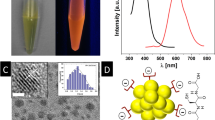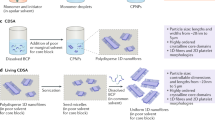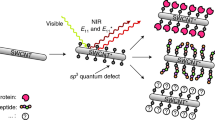Abstract
One of the common strategies to promote the transfer of quantum dots (QDs) to buffer media and to couple them to biological molecules has relied on cap exchange. We have shown previously that dihydrolipoic acid (DHLA) and polyethylene glycol (PEG)-appended DHLA can effectively replace the native ligands on CdSe-ZnS QDs. Here we explain in detail the synthesis of a series of modular ligands made of the DHLA-PEG motif appended with terminal functional groups. This design allows easy coupling of biomolecules and dyes to the QDs. The ligands are modular and each is comprised of three units: a potential biological functional group (biotin, carboxylic acid and amine) and a DHLA appended at the ends of a short PEG chain, where PEG promotes water solubility and DHLA provides anchoring onto the QD. The resulting QDs are stable over a broad pH range and accessible to simple bioconjugation techniques, such as avidin–biotin binding.
This is a preview of subscription content, access via your institution
Access options
Subscribe to this journal
Receive 12 print issues and online access
$259.00 per year
only $21.58 per issue
Buy this article
- Purchase on Springer Link
- Instant access to full article PDF
Prices may be subject to local taxes which are calculated during checkout





Similar content being viewed by others
References
Murray, C.B., Kagan, C.R. & Bawendi, M.G. Synthesis and characterization of monodisperse nanocrystals and close-packed nanocrystal assemblies. Annu. Rev. Mater. Sci. 30, 545–610 (2000).
Michalet, X. et al. Quantum dots for live cells, in vivo imaging, and diagnostics. Science 307, 538–544 (2005).
Medintz, I.L., Uyeda, H.T., Goldman, E.R. & Mattoussi, H. Quantum dot bioconjugates for imaging, labelling and sensing. Nat. Mater. 4, 435–446 (2005).
Hermanson, G.T. Bioconjugate Techniques (Academic Press, San Diego, 2008).
Murray, C.B., Norris, D.J. & Bawendi, M.G. Synthesis and characterization of nearly monodisperse CdE (E=S, Se, Te) semiconductor nanocrystallites. J. Am. Chem. Soc. 115, 8706–8715 (1993).
Peng, Z.A. & Peng, X. Formation of high-quality CdTe, CdSe, and CdS nanocrystals using CdO as precursor. J. Am. Chem. Soc. 123, 183–184 (2001).
Bruchez, M. Jr., Moronne, M., Gin, P., Weiss, S. & Alivisatos, A.P. Semiconductor nanocrystals as fluorescent biological labels. Science 281, 2013–2016 (1998).
Gerion, D. et al. Synthesis and properties of biocompatible water-soluble silica-coated CdSe/ZnS semiconductor quantum dots. J. Phys. Chem. B 105, 8861–8871 (2001).
Wu, X. et al. Immunofluorescent labeling of cancer marker Her2 and other cellular targets with semiconductor quantum dots. Nature Biotechnol. 21, 41–46 (2003).
Yu, W.W. et al. Forming biocompatible and nonaggregated nanocrystals in water using amphiphilic polymers. J. Am. Chem. Soc. 129, 2871–2879 (2007).
Dubertret, B. et al. In vivo imaging of quantum dots encapsulated in phospholipid micelles. Science 298, 1759–1762 (2002).
Mattoussi, H. et al. Self-assembly of CdSe–ZnS quantum dot bioconjugates using an engineered recombinant protein. J. Am. Chem. Soc. 122, 12142–12150 (2000).
Wang, Y.A., Li, J.J., Chen, H. & Peng, X. Stabilization of inorganic nanocrystals by organic dendrons. J. Am. Chem. Soc. 124, 2293–2298 (2002).
Pons, T., Uyeda, H.T., Medintz, I.L. & Mattoussi, H. Hydrodynamic dimensions, electrophoretic mobility, and stability of hydrophilic quantum dots. J. Phys. Chem. B 110, 20308–20316 (2006).
Choi, H.S. et al. Renal clearance of quantum dots. Nat. Biotechnol. 25, 1165–1170 (2007).
Clapp, A.R. et al. Fluorescence resonance energy transfer between quantum dot donors and dye-labeled protein acceptors. J. Am. Chem. Soc. 126, 301–310 (2004).
Clapp, A.R., Medintz, I.L. & Mattoussi, H. Förster resonance energy transfer investigations using quantum-dot fluorophores. Chem. Phys. Chem. 7, 47–57 (2006).
Uyeda, H.T., Medintz, I.L., Jaiswal, J.K., Simon, S.M. & Mattoussi, H. Synthesis of compact mutidentate ligands to prepare stable hydrophilic quantum dot fluorophores. J. Am. Chem. Soc. 127, 3870–3878 (2005).
Mei, B.C. et al. Modular poly(ethylene glycol) ligands for biocompatible semiconductor and gold nanocrystals with extended pH and ionic stability. J. Mater. Chem. 18, 4949–4958 (2008).
Susumu, K. et al. Enhancing the stability and biological functionalities of quantum dots via compact multifunctional ligands. J. Am. Chem. Soc. 129, 13987–13996 (2007).
Hines, M.A. & Guyot-Sionnest, P. Synthesis and characterization of strongly luminescing ZnS-Capped CdSe nanocrystals. J. Phys. Chem. 100, 468–471 (1996).
Dabbousi, B.O. et al. (CdSe)ZnS Core-Shell quantum dots: synthesis and characterization of a size series of highly luminescent nanocrystallites. J. Phys. Chem. B 101, 9463–9475 (1997).
Reiss, P., Bleuse, J. & Pron, A. Highly luminescent CdSe/ZnSe core/shell nanocrystals of low size dispersion. Nano Lett. 2, 781–784 (2002).
Clapp, A.R., Goldman, E.R. & Mattoussi, H. Capping of CdSe-ZnS quantum dots with DHLA and subsequent conjugation with proteins. Nat. Protoc. 1, 1258–1267 (2006).
Leatherdale, C.A., Woo, W.-K., Mikulec, F.V. & Bawendi, M.G. On the absorption cross section of CdSe nanocrystal quantum dots. J. Phys. Chem. B 106, 7619–7622 (2002).
Sapsford, K.E. et al. Surface-immobilized self-assembled protein-based quantum dot nanoassemblies. Langmuir 20, 7720–7728 (2004).
Acknowledgements
We acknowledge NRL, Office of Naval Research (ONR) and the Army Research Office for financial support. We thank Drs Horn-Bond Lin and Igor Medintz for assistance.
Author information
Authors and Affiliations
Corresponding author
Rights and permissions
About this article
Cite this article
Susumu, K., Mei, B. & Mattoussi, H. Multifunctional ligands based on dihydrolipoic acid and polyethylene glycol to promote biocompatibility of quantum dots. Nat Protoc 4, 424–436 (2009). https://doi.org/10.1038/nprot.2008.247
Published:
Issue Date:
DOI: https://doi.org/10.1038/nprot.2008.247
This article is cited by
-
Carbon nanodots combined with loop-mediated isothermal amplification (LAMP) for detection of African swine fever virus (ASFV)
Microchimica Acta (2022)
-
Quantum dots as targeted doxorubicin drug delivery nanosystems in human lung cancer cells
Cancer Nanotechnology (2021)
-
A facile route to synthesize CdSe/ZnS thick-shell quantum dots with precisely controlled green emission properties: towards QDs based LED applications
Scientific Reports (2019)
-
Electrospun Polymer Nanofibers Decorated with Noble Metal Nanoparticles for Chemical Sensing
Nanoscale Research Letters (2017)
-
Preparation of compact biocompatible quantum dots using multicoordinating molecular-scale ligands based on a zwitterionic hydrophilic motif and lipoic acid anchors
Nature Protocols (2015)
Comments
By submitting a comment you agree to abide by our Terms and Community Guidelines. If you find something abusive or that does not comply with our terms or guidelines please flag it as inappropriate.



